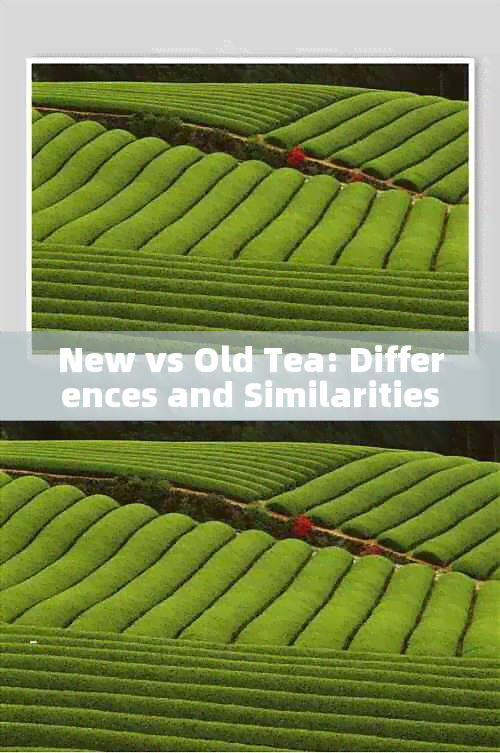- 尚书
New vs Old Tea: Differences and Similarities
New vs Old Tea: Differences and Similarities

Tea, an aromatic beverage beloved by millions, comes in various forms and grades, each offering a unique experience. Among the many types of tea, the distinction between new tea and old tea is one that often sparks curiosity and debate. This article delves into the differences and similarities between new and old tea, exploring their characteristics, production methods, and consumption practices.
The Concept of New and Old Tea
The definitions of new tea and old tea lack a universal standard. Generally, new tea refers to spring tea or one-year-old tea, harvested during the spring season. On the other hand, old tea encompasses autumn tea or tea leaves that are several years old. The age of the tea leaves significantly influences their taste, aroma, and texture.
Differences in Harvesting Time
New tea is typically harvested in the spring, a season that brings forth the freshest and most tender leaves. These leaves are rich in nutrients and exhibit a vibrant green color. In contrast, old tea, which includes autumn-harvested leaves, may ear less vibrant and lack the same level of freshness.
Physical earance
The physical earance of new and old tea offers immediate clues to their age. New tea leaves are often oil润 and fresh, with a tight, well-structured earance. The color is natural and bright, reflecting the vitality of the leaves. Old tea, however, tends to look gray and lackluster, with a lack of vitality and shine. The leaves are also less brittle, making them difficult to crumble.
Aroma
One of the most noticeable differences between new and old tea is their aroma. New tea has a fragrant and aromatic scent that is often described as fresh and invigorating. This aroma is a result of the tea leaves' recent harvest and minimal processing. In contrast, old tea may have a more subdued aroma, sometimes with earthy or musty undertones due to the aging process and potential storage conditions.
Taste
The taste of new and old tea also differs significantly. New tea offers a fresh and brisk flavor, often with a slight astringency. This is due to the presence of high levels of tannins and other compounds that give tea its characteristic taste. Old tea, on the other hand, has a mellow and smooth flavor, with a more rounded and醇厚 profile. The aging process softens the tannins, resulting in a less astringent and more harmonious taste.
How to Differentiate Between New and Old Tea
Determining whether a tea is new or old involves a combination of visual, olfactory, and taste-based observations.
1. Visual Inspection: New tea ears fresh, dry, and loose. The leaves are bright and have a high level of crispness. In contrast, old tea leaves are紧凑, dark, and soft, often resembling tea that has been exposed to moisture.
2. Aroma: New tea has a strong, fragrant aroma, while old tea may have a more subdued scent, sometimes with hints of earthiness or dampness.
3. Taste: New tea has a fresh, brisk taste, while old tea offers a mellow,醇厚 flavor.
Similarities Between New and Old Tea
Despite their differences, new and old tea share some similarities:
1. Production Process: Both types of tea undergo a similar production process, involving withering, rolling, and drying. The difference lies in the aging and storage process.
2. Health Benefits: Both new and old tea offer various health benefits, including improved heart health, reduced stress, and enhanced cognitive function.
3. Cultural Significance: Tea, regardless of its age, holds a significant place in many cultures. It is often used in ceremonies and social gatherings, symbolizing hospitality and friendship.
Brewing Methods
The brewing methods for new and old tea differ due to their unique characteristics. New tea, with its fresh and vibrant flavor, is best enjoyed with higher water temperatures. This helps to extract the maximum aroma and flavor from the leaves. On the other hand, old tea, with its mellow and醇厚 taste, benefits from a lower water temperature to prevent bitterness and enhance the overall experience.
Conclusion
New and old tea offer distinct experiences for tea enthusiasts. While new tea provides a fresh and invigorating taste, old tea offers a more mellow and醇厚 flavor profile. Understanding the differences between the two can enhance one's reciation of tea and its cultural significance. Whether you prefer the crispness of new tea or the richness of old tea, each type offers a unique and enjoyable experience that can be savored and cherished.
In conclusion, the world of tea is vast and varied, with new and old tea representing just two of the many dimensions of this fascinating beverage. Embracing both can enrich our understanding and enjoyment of tea, making every cup a journey of discovery and delight.
- 延伸阅读主编精选推荐
- 荐 新茶和旧茶有什么区别
- 荐 新茶旧茶功效对比:哪一种更有益?
- 荐 如何从色泽、香气和口感等方面区分新茶与陈茶?
- 荐 绿茶新茶与旧茶的对比:品质、风味、保存方法及价格方面的全面解析
- 荐 西湖龙井新茶与陈茶的品鉴之道:口感、香气与保存技巧的全方位对比
-
茯茶与砖茶:它们之间的区别和联系,以及如何选择最适合您的茶叶?咨询 24人阅读
-
深入剖析茯砖茶与传统黑砖、花砖的制作工艺及口感差异咨询 23人阅读
-
茯茶和砖茶哪个更好:口感与品质的对比分析咨询 22人阅读
-
茯茶与砖茶的区别、种类、功效以及如何选择:一篇全面解析咨询 29人阅读
-
茶叶中的秘密:哪种茶能有效保护肝脏和胃肠健?咨询 24人阅读
-
'哪种茶养肝护肝排肝效果好:答案与建议'咨询 27人阅读
-
全方位比较:哪些茶叶具有的养肝护肝效果?咨询 24人阅读
-
探索茶的奥秘:哪种茶叶最有益于肝脏健?咨询 23人阅读
-
喝什么茶养肝护肝?效果的排茶推荐咨询 21人阅读
-
含硒更高的茶品种及其功效一览:哪种茶叶的硒含量更高?咨询 21人阅读
-
比较调味茶和普通茶:哪个更适合您?了解两者的优缺点以便做出明智的选择咨询 26人阅读
-
调味茶和茶哪个更有营养:全面对比分析咨询 18人阅读
-
茶叶品种与品质:普洱茶中好茶与次茶的鉴之道咨询 15人阅读
-
深入了解杀青与炒茶工艺:它们的区别、相似之处以及如何在实际操作中运用?咨询 23人阅读
-
杀青是炒茶吗?了解炒茶与杀青的区别和关系咨询 23人阅读
-
探索普洱茶制作工艺:炒茶中的杀青环节解析咨询 14人阅读
-
茶叶杀青与炒青的详细区别解析:从工艺原理到口感影响全方位比较咨询 16人阅读
-
炒茶什么叫杀青:掌握茶叶制作关键步骤的意义解析咨询 16人阅读
-
2021年倚邦古树茶云南普洱茶批发价格与图片指南咨询 19人阅读
-
2017年倚邦古树生茶:品质特点、制作工艺与品鉴方法全方位解析咨询 22人阅读